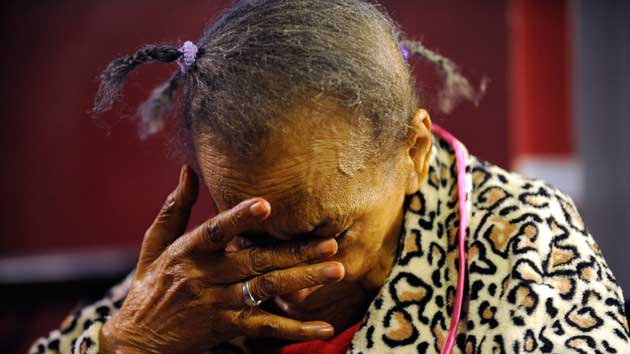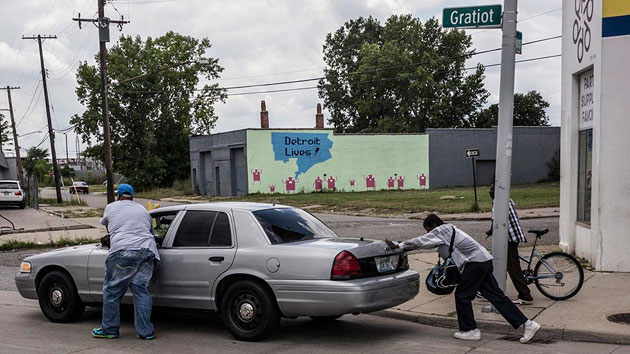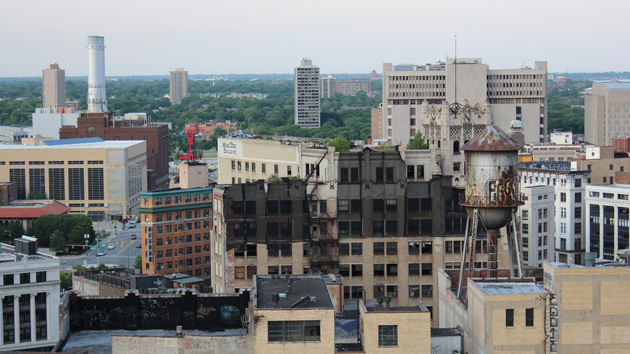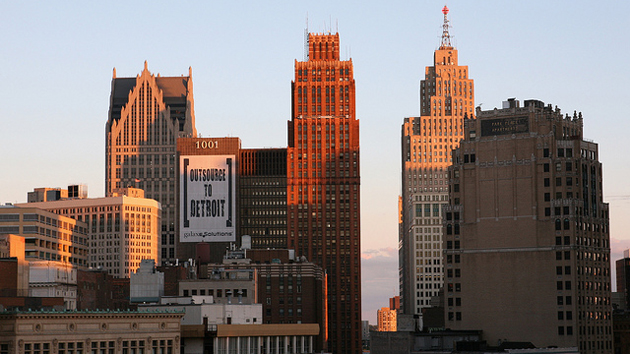
<a href="https://www.flickr.com/photos/lundgrenphotography/7980664930/in/photolist-dadZDd-bMDJjv-7x5Ujj-4Gf6tb-4hvoPQ-6kx8Ld-4GfaLj-6kAAJZ-r4dMEr-9bH4wd-q9bmDC-7x61ko-6oGp5Z-Dgx2b-htcWwt-ncTvy-r25BSU-gznkSw-5EEeFC-5nJLRb-5F9wnD-jVKsL-bschWs-6kBab8-apac9U-4waVRf-6vSYET-4SKHcY-5r8Bya-6PCdT1-6ktCEK-HF8SC-6ksXD8-6kEEJ7-nVoFqw-9udNrf-9uaMWV-9uaMyH-cAj7tq-6kAo36-qxEChC-HF8Su-aewcdc-fJwhxh-96wGvF-96zM1A-96zLeL-cRZBad-beygxF-6oBWM">Jess</a>/Flickr
On August 30, 2013, a billionaire businessman named Dan Gilbert arrived at the White House to discuss the future of Detroit. Gilbert, founder and chairman of Quicken Loans and owner of the Cleveland Cavaliers, had already invested heavily in the city; in 2010 he moved Quicken’s headquarters from the suburbs to downtown and relocated several of his businesses along with 12,500 employees. Six weeks before that White House meeting, the city had filed for the largest municipal bankruptcy in US history. Gilbert was in Washington as part of an elite delegation to discuss federal assistance for the country’s most visibly dysfunctional city.
The heads of the Kresge and Ford Foundations—large philanthropies that have roots in Detroit’s industrial past and continue to invest in the city—were there, as well as the CEO of the Henry Ford hospital system and the then-chair of Wayne State University’s Board of Governors. According to the Detroit News, the group met with senior administration officials including then-HUD Secretary Shaun Donovan, President Obama’s advisor Valerie Jarrett, and Gene Sperling, who was the director of the National Economic Council.
The months leading up to the bankruptcy highlighted the depth of Detroit’s ongoing problems. More than one-third of residents live in poverty and, since 2008, tax foreclosures have pushed 27,000 occupants out of their homes. Michigan’s Republican governor had appointed an emergency manager to run the city, with the authority to renegotiate or cancel union contracts, hire and fire government employees, and sell, lease and privatize local assets. The city was often unable to provide basic municipal services like streetlights that worked or alarms for the fire department. The schools? Don’t even ask.
At the White House, Gilbert banged his fist on the table. “The one thing you guys have got to do,” he thundered “is figure out how to help us do this blight work.” To save Detroit, he told the assembled officials, they needed to help tear down Detroit. By tearing down tens of thousands of buildings —some still occupied, some abandoned—they would make room for new, vibrant neighborhoods.
Gilbert’s fist-pounding proved persuasive. Several weeks after the White House meeting, the Obama administration pulled together a $300 million aid package for Detroit, made up of combined federal and private dollars. There was money to hire firefighters, repair buses and begin the construction of the M-1 Rail, a $140 million trolley line that will travel 3.3 miles through the city’s gentrifying downtown. But almost half of the total was earmarked for blight removal, and Gilbert himself became co-chair of a task force charged with identifying the demolition targets. There are no minutes of the White House meeting, so it’s impossible to know what discussion there was about the blight-removal approach. It also appears that not a single representative of the neighborhoods soon to be bulldozed—no minister, no community organizer, no teacher or city council member—attended the meeting. The closest person to a community representative was Dennis Archer, who had served as Detroit’s mayor from 1994 to 2001.
This is the fundamental dynamic that has played out throughout Detroit’s crisis and recovery: The city’s future is being determined by politicians, business leaders, and philanthropists while native Detroiters—more than 80 percent of whom are black—often can only watch from afar. Peter Hammer, Director of the Damon J. Keith Center for Civil Rights at Wayne State University’s Law School, describes the plans for Detroit as “the suburban view of what a city should look like. It’s not a view of the city that’s responsive to the needs of the citizens of Detroit.”
What has happened to Detroit in the almost two years since the White House meeting? When I visited last year, I tried to peel back the layers of grievance, recrimination, and dysfunction I’d noticed in the way many Detroiters talked about the changes in the air. I met philanthropists and neighborhood leaders, academics, entrepreneurs and lifelong residents, each of whom had their own perspective on what is working, what isn’t, and what still needs to be done. What has all the attention and all the money accomplished in a city that was about to collapse? Now that Detroit is no longer bankrupt, who are the winners and who are the losers?
Dan Gilbert was one of the big winners—at least until April of this year, when Quicken was sued by the Justice Department because of hundreds of allegedly bad loans that were funneled through the Federal Housing Administration. Still, his downtown world, only blocks from neighborhoods his task force designated as blighted, is the picture of cool urban prosperity. One sunny day the lunch crowd ordered from food trucks lined up in Campus Martius Park, a handsome square surrounded by Gilbert’s buildings. By the end of 2014, he had invested a reported $1.6 billion in Detroit and had acquired more than 10 million square feet of property, a total three times greater than Manhattan’s One World Trade Center. The workers at his galaxy of Detroit companies include everyone from blackjack dealers at the Greektown Casino to loan officers to marketers. Roughly 80 percent of them live outside Detroit. I spotted outdoor pianos (the New York Times photographed him sitting at one) and an artificial beach next to a monument for Michigan’s Civil War dead. Kids played on basketball courts. During the World Cup last summer, Gilbert’s organization hosted huge viewing parties in the park.
Gilbert’s buildings house some of the most attractive offices you’ll find anywhere—bright, airy spaces set off by touches of Silicon Valley whimsy and Brooklynesque glamour. There are free slushies. In the basement of a century-old neoclassical high rise, bank vaults have been repurposed as funky conference rooms. The space serves as the headquarters of dPOP!, an interior design firm for offices co-founded by Gilbert’s wife Jennifer. Gilbert’s representatives declined to make him available for this article but he told the tech site RE/Code that he thinks the space is the coolest in Detroit.
For a certain class of mostly white creative professionals seeking affordable living and urban adventure, Detroit has become a destination. In December the celebrated Brooklyn arts space Galapagos, which hosts concerts, exhibits, theater and other events, announced that it had been priced out of New York and would relocate to Detroit—where its arrival has, inevitably, raised concerns about rising rents pushing out longtime residents.
During the harsh winter of 2013-14, the Blight Task Force that Gilbert co-chaired hired both Data Driven Detroit* and LoveLand consulting group to identify blighted properties parcel by parcel over Detroit’s 139 square miles and catalog their findings on tablet computers.
The survey found about 84,000 properties in need of intervention—more than a fourth of the city’s parcels. The task force acknowledged that Detroit’s concerns include crime, jobs, and education, but insisted that “significant progress” in these and other areas will be impossible without eradicating blight, which they described as “a cancer [that] sucks the soul out of anyone who gets near it, let alone those who are unfortunate enough to live with it all around them. Blight is radioactive. It is contagious.”
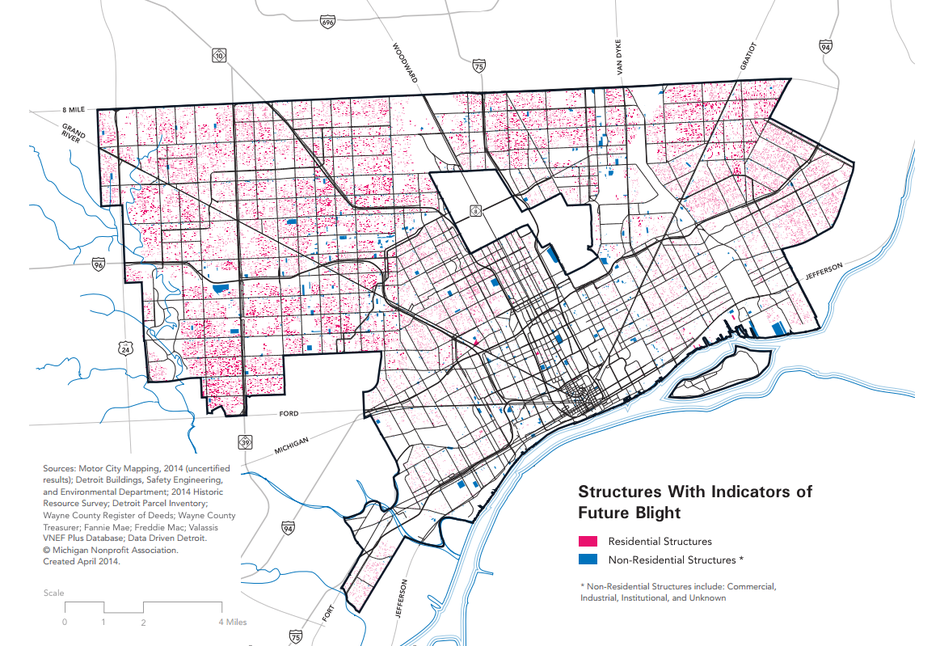
The Task Force noted that of the 84,000 blighted properties they targeted, more than 70,000 were unsalvageable and needed to be torn down, while the rest might be rehabilitated. Nobody knows how many of those buildings are occupied and the report does not include a detailed plan for relocating any residents. The report does include recommendations for how to speed up the city bureaucracy so that homes can be demolished more quickly, including those that appear to be occupied.
In the end, the task force recommended spending $850 million, primarily on demolishing residential and small commercial buildings. It acknowledges that destroying the city’s large industrial ruins, like the immense Michigan Central Station, which closed in 1988, would cost an additional $1 billion—about the same as the city’s total annual budget. In an email, a spokesperson for Gilbert said they expected the funding needed to get to the initial $850 million target would come from “public and private sector sources.”
Today, Detroit is well on its way to fulfilling Gilbert’s dream. In early June, a spokesman for the mayor told me the city had demolished 105 houses in a single week and was hoping to pick up the pace to between 150 and 200. Detroit has enough money to continue this program through October of 2015 and is seeking more funding to complete the process.
Blight removal is not unique to this period in Detroit’s history. It was also a strategy in the “urban renewal” era in the fifties and sixties, when thousands of black families were displaced from slums because planners thought that vacant land was more valuable. More recently, blight represents the lost fortunes of ordinary Detroiters. It is the ghost of Detroit’s remarkable post-war reign as an industrial Mecca, a place that drew tens of thousands of young men and women from Kentucky and Ohio and West Virginia and Tennessee.
The commission acknowledged in the report that its mission is not to examine the causes of blight. But others did offer explanations—including George Galster, an urban affairs professor at Wayne State, who argued in the Detroit Free Press that new blight will continue to occur as Detroiters continue to flee for the suburbs. A more comprehensive fix, he argues, would require restrictions on suburban growth so that energy and money could be redirected to homes and business buildings that already exist. “Blight in Detroit,” he wrote, “is fundamentally the result of processes at work outside of the city’s boundaries.”
One afternoon last summer I went to St. Peter’s Episcopal Church, a sturdy brick edifice in the gentrifying Corktown neighborhood west of downtown, and met with two community organizers, Monica Lewis-Patrick and Tawana Petty. They were there to help neighborhood residents whose water had been recently cut off for lack of payment. The city had failed to correctly track water use and begun shutting off service to delinquent accounts, which were reportedly almost half of the 323,000 accounts in the city. That had never happened in the past, giving many who lived there a false sense of security as unpaid bills mounted, reportedly reaching $90 million. Now, in a city sitting next to one of the largest sources of freshwater in the world, more and more residents were left without any water and big bills.
The community had figured out how to cope, at least marginally. Lewis-Patrick, who has short graying hair and wore a fading t-shirt, said her neighbors were leaving their back doors open so that others could use the bathroom or take a shower. In the church’s sanctuary, hundreds of gallon jugs shipped in by a group in West Virginia lined the floor beneath the stained glass windows, free for anyone in need. “Illegal pharmaceutical salesmen, the dope boys” were helping to distribute water, Lewis-Patrick said while smiling, showing off her braces. “It’s giving them a reason to hold their heads high.”
A widely held view among Detroit activists was that the water-bill collection effort was an attempt to clean up the Detroit Water and Sewerage Department’s books to prepare it for a sell-off or other transfer of authority. Indeed, in September, the emergency manager put the department under the control of a regional water authority.
Many residents also suspected that turning off the water was about more than delinquent bills—they worried about driving Detroit’s poorest citizens out of town. “When you get your water cut off and they say ‘You have to pay $1,700’ and you tell them you don’t have any money, what are you going to do but move?” said Alice Jennings, a lawyer who is involved in an ongoing legal battle over the shutoffs. Jennings welcomes educated whites “coming in and being a part of our recovery,” but not at the expense of pushing Detroiters out of their own city.
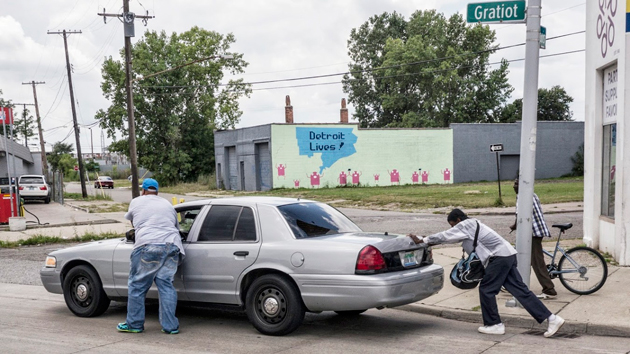
Less than 4 miles from St. Peter’s sit the offices of Detroit Future City, a project created by seven major foundations to develop a model of what Detroit could become. Its 354-page report can be read as a recommendation by some of Detroit’s most powerful interests for the new and improved city once blight is gone. It does not, however, address what Peter Hammer, the academic, said is the root of Detroit’s decay—a “complete segregation” between it and its suburbs, a segregation “not just of race, but of wealth.”
I visited DFC officials in their office on Grand Boulevard near Cadillac Place, a grandiose building with four towers that was once General Motors’ headquarters and is now an office building. The DFC panel I met included executive director Kenneth Cockrel Jr., who previously served on Detroit’s city council for 16 years, and Heidi Alcock, DFC’s director of operations. We spoke for more than an hour about their years of research and community outreach. In keeping with modern views of urban planning, they described a new Detroit of clustered commercial and residential areas, while much of the remaining real estate would be transformed into parks and ponds. If the plan is fully realized, which would likely take decades, some areas where people now live will be underwater.
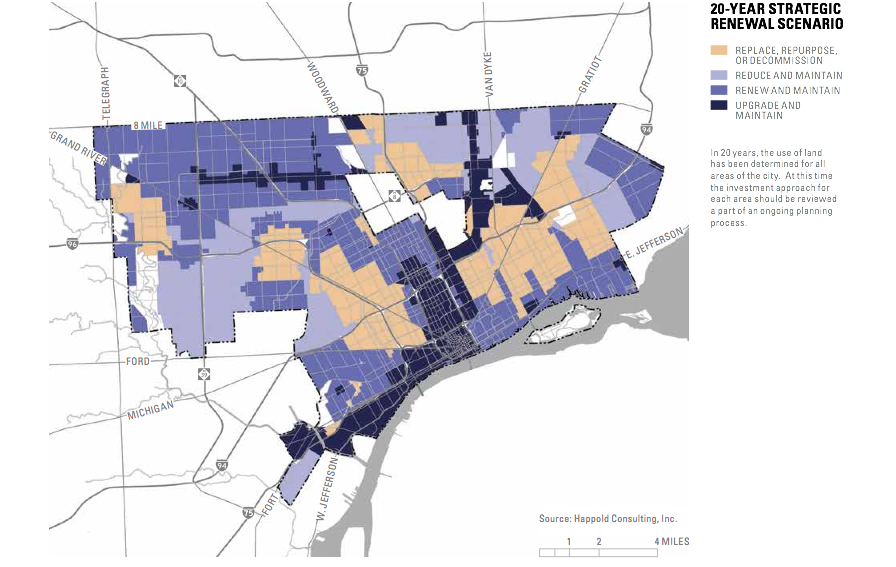
Richard “Rip” Rapson is head of the $3.5 billion Kresge Foundation, which helped to fund DFC and has provided $150 million to implement their proposal. I visited Kresge’s offices in the suburb of Troy where Rapson, a senatorial figure with a swoop of silver hair, told me it was the “most sophisticated community engagement process that’s happened in America in the last 20 years.”
“We can tear down all of the houses we want,” Rapson continued. “But unless we create attractive, livable communities for people to live and perhaps start a business in, what’s the point?” Rapson said Detroit needs “public systems that ultimately will invite the citizens of Detroit back into the mainstream economy.”
One of the systems Kresge, Ford, and others have pushed is the M-1, a rail line that will travel north-south along a 3.3 mile track through greater downtown, the center of Detroit’s revival. When it is completed in late 2016, passengers will board in the southern terminus, at Congress St. near a 24-foot statue of Joe Louis’ fist, and then proceed up Woodward Ave through Gilbert’s properties, past the boxy white Opera House, Comerica Park (home of the Tigers), and the baroque Fox Theatre, where Eminem pulls up at the end of his famous Chrysler commercial.
After crossing the interstate, M-1 riders will pass through what’s now a non-descript landscape where Mike Ilitch, a billionaire who founded Little Caesar’s Pizza and owns the Tigers and the Red Wings, is building a new arena for his hockey team. That is the anchor for a $650 million residential and entertainment district. Next comes “ed and meds”: a swath with Wayne State University and two large hospitals that’s also the center of Detroit’s start-up scene. The area boasts a Whole Foods while last summer, the rest of Detroit had almost nothing you could call a supermarket. The trolley’s final stop will be West Grand Boulevard, where passengers can take in the Fisher Building, an imposing imposing edifice that recalls a past when the city was the richest in the world.
Detroit is desperate for public transit. More than a quarter of households in the Motor City don’t have cars. Cars are expensive, and Detroit has the most expensive car insurance rates in the country. Last winter a Detroit factory worker who walked 21 miles to and from work became an internet sensation. Yet the M-1 looks for many Detroiters like a shuttle between jobs they can’t get and housing they can’t afford. A single diesel bus, the kind that most cities use, costs around $300,000; the $42 million cost of a single mile of the streetcar would buy 140 of them. The M-1 corridor “is being made accessible to suburbanites and hipsters” Petty, the activist, told me. “If you go ten minutes away, the traffic lights don’t work, and the garbage isn’t being picked up on time, and water is being shut off.”
The Kresge Foundation’s Rapson, who sits on the M-1’s board, said it’s important for the city’s self-image to complete a major infrastructure project. Like the rail’s other supporters, he says it’s just the first step of a not yet funded regional transit network that will one day connect Detroit with workplaces in the suburbs and beyond. Boosters held out similar hopes for the People Mover, a driverless elevated rail that opened in the late 1980s and continues to loop forlornly around the central business district, with fewer riders in a year than the Washington Metro carries in three business days. M-1 supporters expect ridership to be roughly the same as the People Mover.
On Wednesday December 10, 2014, Detroit Mayor Mike Duggan, Gov. Rick Snyder, and then emergency manager Kevyn Orr gathered to announce the end of Detroit’s bankruptcy and the beginning of new self-determination for the city. The crushing $7 billion debt was forgiven, and the plan gives the city $1.7 billion to spend over the next ten years. “We still have enormous challenges delivering services in the city every day, but at least now we are no longer a city that’s in bankruptcy,” said Duggan, who had been in office for almost a year, but had little power because Orr was managing the city. “So we’re going to start fresh tomorrow. And we’re going to do the best we can to deliver the kind of services that the people in the city deserve.”
Detroit is overwhelmingly Democratic, but as the Republican presidential race has gained speed, it has also become a backdrop for GOP candidates eager to reach out beyond their traditional base while hewing close to their core message. Sen. Rand Paul has called for inner cities like Detroit to be declared low-tax “economic freedom zones.” He may not have realized that Detroit has been a focus of Michigan’s “Renaissance Zone” program, and there are currently at least eight parts of the city where residents and businesses receive tax incentives. Campus Martius, the center of Dan Gilbert’s empire, is one of them. In October, Paul told a Republican gathering in wealthy Oakland County, which borders Detroit’s Wayne County to the north, “We need to go into Detroit and say ‘We want to help, and we care.'”
In February, Jeb Bush went to Detroit for his first speech after suggesting he might become a presidential candidate. He took swipes at big government and paid homage to Detroit’s innovative past as “the Silicon Valley of its age.” And on May 4, Ben Carson announced his presidential bid at the Detroit Music Hall. He spoke about growing up poor in Detroit and declared that “it is time for the people to rise up and take the government back.”
In national politics, Detroit is now a symbol, one that can be wielded by Democrats and Republicans alike. Governor Snyder, who is wildly unpopular in Detroit, won reelection in November and he has praised Detroit’s exit from bankruptcy as ensuring the city’s “bright future.” As a two-term blue-state governor, he’s a compelling GOP vice-presidential contender. And Detroit’s gritty allure continues to build hipster cred far beyond politics. This month the Detroit–born musician Jack White, of The White Stripes, bought a building in the gentrifying Cass Corridor, area. The building currently houses a Shinola store selling neo-retro bikes for $1,000 and up.
Something will rise on Detroit’s land. The question is who will be there to see it.
“Detroit is only Detroit because of Detroiters,” Lewis-Patrick, the community organizer, told me. “There are those who would like to turn Detroit into a brand…What they are seeking to commandeer is the heart and soul of the city.”
*The Task Force also hired Data Driven Detroit to work in partnership with LoveLand Consulting Group to identify blighted properties.


